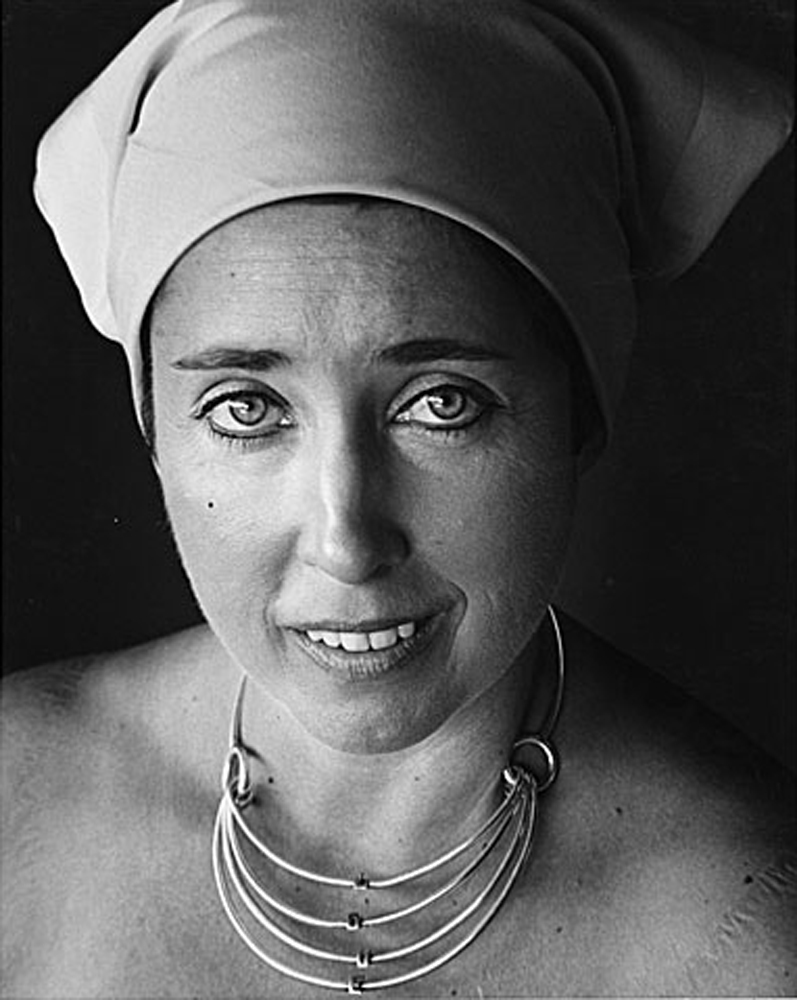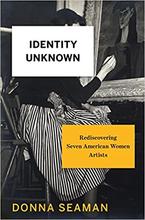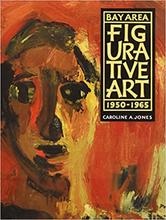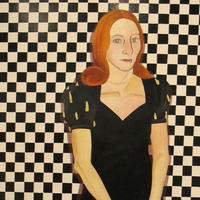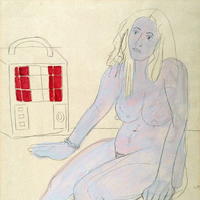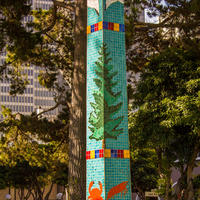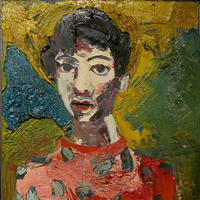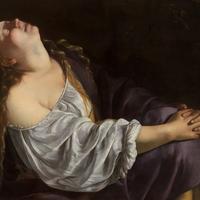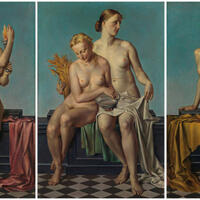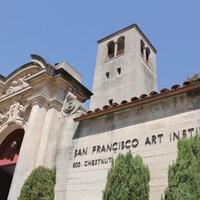More about Joan Brown
- All
- Info
- Shop
Works by Joan Brown
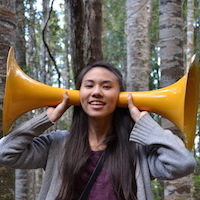
Contributor
A young Joan Brown attended Catholic school, where the closest she got to making art was copying the pictures on the covers of religious calendars.
As she got older, she transitioned from copying calendar covers to copying magazine pictures. Eventually, she decided to attend the California School of Fine Arts where she had a reputation for being covered in paint from head to toe, as she succumbed to her unbridled artistic yearnings.
Brown is what one would call a “serial monogamist.” She was married four times throughout her life, and though she was the profane, feisty type herself, she usually preferred the sad, brooding type for a husband. Her most notorious union was her second marriage to artist Manuel Neri, with whom she had a child named Noel. Because a simple photo album could not suffice, Brown kept a baby book where she noted the intimate moments she shared with her son. Aside from the usual birthday parties and visits to the doctor, she also recounted an incident when Noel ate part of one of her paintings, Girl, Dog, and Clouds. Bad baby.
Ever since she was young, Brown had an affinity for animals and included animal motifs in many of her pieces. Bob the Dog, Neri’s pet bull terrier makes appearances in many of Brown’s paintings during their marriage, as does Allen (a white dog with a black patch), Rufus (a half Labrador and Australian shepherd), and Donald the cat.
In addition to being a nationally-acclaimed artist, Brown was also a medal-winning swimmer, though she was not always successful in her endeavors. In 1975, she participated in the Alcatraz Swim in which brave souls swim from Alcatraz Island to the cove of Aquatic Park. In the end, fourteen out of the twenty-three women who participated made it ashore. Unfortunately, Brown was not one of them and instead of winning a medal, she got hypothermia. She experienced what is referred to as “freaky” water where swirling water currents completely confuse the swimmer. She swam in circles a quarter mile away from the coast of the cove, hallucinating about Hawaiian islands and palm trees, before eventually being pulled out of the bay. As if us artsy types needed yet another reason not to try sports.
Towards the end of her life, Brown revisited her spirituality and developed an interest in ancient cultures and mysticism, eventually embracing a New Age belief system. She considered Sathya Sai Baba— the modern Indian spiritual leader (or scam artist depending on what you believe)— as her spiritual guide. Unfortunately, in 1990 Sai Baba spiritually-guided Brown to Puttaparthi, India to install her obelisk piece at the Eternal Heritage Museum in honor of his sixty-fifth birthday. During this time, the museum was still under construction, and a turret inexplicably became loose, fell, and crushed the poor artist at the age of fifty-two.

Contributor
Joan Brown sought to remove her own conscious choices from her work, like Warhol, by focusing entirely on her relationships and environment.
Brown once said, "The images, ideas and techniques in my works only serve to reflect my thoughts, feelings, attitudes, beliefs, relationships with other people and my daily perception of the environment I exist in." Toward the end of the epic year 1968, the artist married her third husband. A couple of months later, her father died, and her mother hung herself six weeks thereafter. Marisol Escobar also suffered the loss of her mother to suicide.
Brown's childhood was marked by an alcoholic, but gentle father, and a mother who regularly mused about the possibility of suicide, particularly, jumping from the Golden Gate Bridge. As a child, this kind of talk was terrifying to the artist, and she carried such a burden from it that she described her mother's death as a relief, although at first it felt like losing "an arm or a leg."
"I think my life with my mother and father was a very gift-giving situation, as painful or negative as it might sound," she said. The "gifts" included the impulse not to behave like her mother and grandmother, and how to be gentle and receptive like her father.
Her education with the Bay Area Figurative painter Elmer Bischoff led her to study mysticism, especially within the ancient traditions of India and Egypt. She followed dreams and her unconscious insight, affirming that she was unaware of the meaning of most of her works. This intuitive approach, like the automatic writing of the poet friends of her neighbor Jay DeFeo, plays with the boundaries of magic, sorcery, hypnotism and spiritualism.
She became friends with the late, controversial Indian guru Sathya Sai Baba, although she was not his disciple. The eccentric man had been stung by a scorpion at the age of 14 and began speaking in Sanskrit, claiming that he was the reincarnation of Shirdi Sai Baba, a sage who had died eight years before Sathya was born. The legend of Shirdi Sai Baba, whose original name, birthdate, hometown and ethnicity are still unknown, includes accounts of him removing his own limbs and reassembling himself, in the practice of "khand yoga." Shirdi Sai Baba is, to this day, a holy man to both Hindus and Muslims, suggesting, maybe, that culture is a mosaic of seemingly different faith systems. In any case, it suggests that people love magic tricks. Sathya Sai Baba, if you have faith in this kind of thing, miraculously materialized jewelry and holy ash from his body.
The obelisk is the Western cousin of the Indian phallic lingam, symbolizing Shiva, the master of sexuality, material destruction and transformation, in union with his consort, Shakti. Shiva is so united with Shakti that s/he even appears as Ardhanarishvara, the half-male half-female androgyne, in some temples. Brown placed obelisks in Beverly Hills and Walton Square, San Francisco before accepting a commission from Sathya Sai Baba to install one at the Eternal Heritage Museum at Sai Baba’s ashram in Prasanthi Nilayam, India. On October 26th, 1990, along with two of Sai Baba's devotees, she perished when a tower in the museum collapsed. She was survived by her husband, a captain of the San Francisco Police Department, and her son from an earlier marriage to the sculptor Manuel Neri. Her son Noel is an artist whose work is heavily influenced by his mother.
Sources
- "Biography." The Joan Brown Estate. October 14, 2018. Accessed July 15, 2019. https://web.archive.org/web/20160129083921/https://www.joanbrownestate….
- Chaturvedi, B. K. Sai Baba of Shirdi. Edited by Satya Pal Ruhela. New Delhi: Diamond Pocket Books, 2000.
- Daniélou, Alain. The Phallus: Sacred Symbol of Male Creative Power. New York: Simon and Schuster, 1995.
- Kher, V. B., and M. Y. Kamath. Sai Baba of Shirdi. Mumbai: Jaico Publishing House, 1991.
- Schwartz, Stephen. "Guru Followers Killed with Joan Brown." The San Francisco Chronicle, October 30, 1990.
- "The Paintings Are All a Reflection of Joan." San José Museum of Art. September 30, 2014. Accessed July 16, 2019. https://sjmusart.org/video/paintings-are-all-reflection-joan-noel-neri-….
- Tsujimoto, Karen, Jacquelynn Baas, and Brenda Richardson. The Art of Joan Brown. California: University of California Press, 1998.
Featured Content
Here is what Wikipedia says about Joan Brown
Joan Brown (born Joan Vivien Beatty; February 13, 1938 – October 26, 1990) was an American figurative painter who lived and worked in Northern California. She was a member of the "second generation" of the Bay Area Figurative Movement.
Check out the full Wikipedia article about Joan Brown

